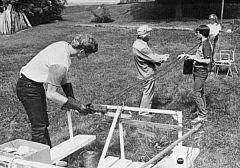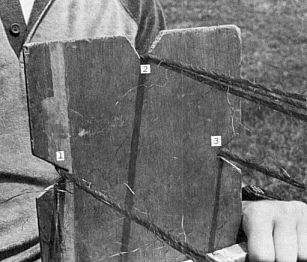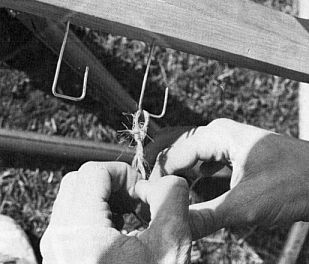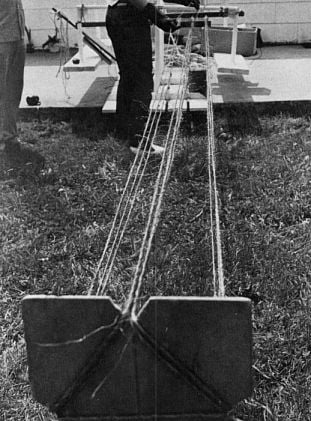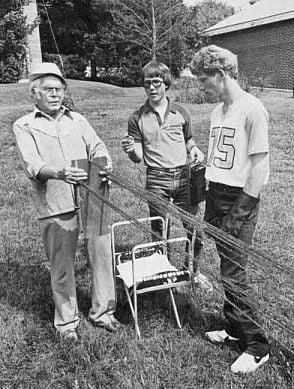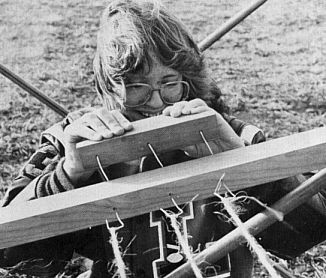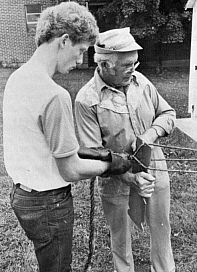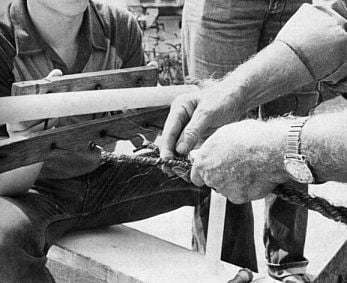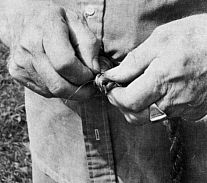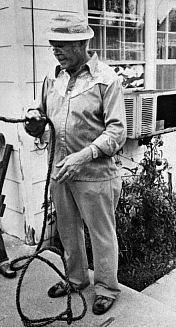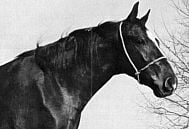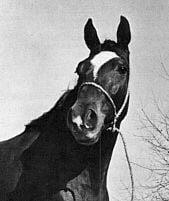Using Sam Schendel's old-time machine
Bittersweet, Volume X, No. 3, Spring 1983
by John Williams
Photos by Allen Gage
"I've made ropes ever since t was a child," said Sam Schendel, a veterinarian who grew up on a farm where ropes were a necessity but not always readily available. Even now, after forty years of veterinary practice, he still makes the ropes he needs in his work. The stiff ropes become good lassoes which he expertly tosses over his unwilling patients' heads. Once caught, he holds the cows or calves with halters he quickly fashions from his homemade ropes.
"Back in eastern Kansas when I was in the second or third grade, my cousin who was in high school made a rope making machine," he said. "It had a handle, two flat boards and a chain from an old corn binder. The chain rolled three separate sprockets and had three different plugs that turned.
"My dad made one out of a Model T steering wheel. There was kind of a gear box below the steering wheel which had about three gears in it. It had plugs welded on it so he could turn the steering wheel, and it would turn these three hooks to make a rope.
"We made a very long rope for a hay barn. To lift the hay up and drop it in the loft, you had to have a very solid rope about a hundred yards long. One afternoon my dad, my uncles, two cousins and us boys in our family spent all afternoon running back and forth across the prairie making rope that stayed with us and became the hay barn rope."
Both the rope machine and the rope itself are easy to make using simple materials. Following are instructions for making the machine, instructions for making rope and for making a halter from the rope.
THE ROPE MAKING MACHINE
The rope making machine is really quite simple, made from scrap materials found on any farm. It is made of one long board with three wire hooks through it. The hooks are connected to a handle which turns all three hooks at the same time.
Materials and Equipment
1- 2 x 2 board 34 inches long
1- 1 x 2 board 8 inches long
1 yard medium weight wire
6 washers
saw
drill
needle nose pliers
sandpaper
The long board must be long enough to fasten to something stable like a doorway, stairway railing or fence. To make it, cut the wood the desired length. Using a 1/16 inch drill bit, or a bit slightly larger than the wire used, drill 3 holes in it 4 inches apart for the hooks. The middle hole should be in the center of the board. Measure the holes carefully so the center of each hole is four inches from the center of the next hole. Also, the holes should be drilled straight through the board. If the holes angle, the wire hooks will bind. Drill two holes at each end of the board. These do not have to be any certain size or distance apart because these are for attaching the machine to a support with a rope or bolts when winding the plies of rope material.
To make the handle, cut the board the desired length. Drill three holes in the board, spaced exactly as those in the long board. The center hole should be in the center of the board with the other holes 4 inches apart. After putting the wires through the handle, Dr. Schendel nailed a smaller board to the back of the handle to make it easier to grip. The size of the handle and this extra board depends on the individual using the machine. The handle should be easy to grip. The boards may be sanded for a smoother finish.
The hooks should be made of medium weight wire. Wire from a clothes hanger is about the proper weight. Dr. Schendel used, among other things, wire from an old phonograph stand to make his hooks. Cut three wires 10 inches long. Measure the first wire 2 inches from one end of the wire and bend at a right angle with wire pliers. Needle nose pliers work well for this. Next measure 2 1/2 inches from this angle and bend another right angle in the opposite direction from the first angle. Do this with the other two wires making angles exact on all three wires. Stick the shorter end of one wire through a hole on the handle. To keep the handle from slipping off the wire, place a couple of small washers on the wire and bend the end of the wire over double. Do this to the other two wires.
BITTERSWEET staff learns to make three ply rope from Sam Schendel who has made rope for many years. John Williams and Jeff Zander help make rope. John turns the rope machine handle to twist the plies tightly while Sam instructs Delilah Shotts how tight to hold the board. Jeff runs his hand across the sisal plies to untangle them.
After all three wires are fastened to the handle, they must be attached to the long piece. Put the other ends of all three wires through the corresponding holes in the long board. The ends should extend about 3 1/3 inches on the other side of the board, enough to form a hook. Measure 2 inches from the board on each wire and bend in a right angle. Measure another 3/4 inch and make a second angle bend forming a hook. Make sure all the hooks are bent in the same direction. If all the wires are bent properly, the handle should turn all the hooks evenly without any wire binding. You may put a drop of oil or graphite on the wire where it passes through the hole in the board to make it turn easily. This completes the main part of the machine.
The other part is a small, notched rectangular winding board. The twine is stretched around this board that is used to separate the plies. A plywood board about 15 inches by 7 inches is a good size and weight. Cut three notches in the board about 2 inches deep, one at the top, one at the left side and one at the right. The notches need to be deep enough so the strands do not slip off the board.
The board that is used in winding the strands has three deep notches. It is made from any kind of scrap board.
Start first by making a loop knot. Work the end left from the loop knot into the strand by separating and pulling through.
MAKING THE ROPE
Ropes can be made of several materials-rug yarn, sisal, or any binder twine, nylon or even leather.
Rug yarn is easily available as almost every store carries it. It is easy to work with and comes in a variety of colors. Sisal is also available from many stores, including craft stores. It comes in colors. Sisal makes a tough rope that can withstand a lot of wear. Nylon also makes a tough, durable rope. A rope made from leather strips could be used for decoration.
In addition to the twine to make the rope, you need a rope ring to finish off the end. A hog ring works well for this.
Before you begin making the rope, have handy a pair of pliers, an ice pick, scissors and, if using sisal, gloves to protect your hands.
Anchoring the Rope Machine
The machine needs to be anchored to something stable because of the pull on the machine from the tension in the strands as they are stretched tight. Dr. Schendel anchored his machine to an upside down picnic table. Other places to anchor the machine are doorways and fences, but allow space for a person be
hind the machine to turn the handle. Also allow space in front for the length of rope you want to make. Anchor the machine either by tying it with rope or bolting it. Dr. Schendel said, "The old-timers used to have a picket fence around the yard to keep the cows and hogs from getting in. They would just bore holes in the picket fence and when they wanted to make rope, they would attach the machine to the fence and start right out making rope."
People Needed to Make Rope
It takes three people to make rope. Although you can make rope with two or even one person, three make it easier. One person winds the rope by turning the handle of the rope machine. Another person holds the winding board the strands are stretched around, while the third person twists the plies into rope.
Attaching the First Strand to the Machine
Attach the first strand to the machine by making a slip knot about an inch long. Put the loop over the first hook on the right side as you face the machine. Work the end of the string left from the slip knot into the strand by opening the strand and pulling the end through so no end is visible. After attaching the strand to the machine, you are ready to stretch it around the winding board.
This is what the board looks like with the material on it after you are started and in the back you can see the shape of the triangle.
Stretching the Strands around the Board
The purpose of the winding board is to keep the strands separated and to keep them taut as they are wound. The board may be fastened to something solid, or a person can hold the board while winding the material on the board. The board needs to be as far away from the machine as the length of the rope is going to be. The rope shrinks about one fifth of the strand length. For example, if the finished rope is going to be 12 feet long, start with a strand length of 15 feet.
The following instructions are for a three ply rope.
The first strand is fastened on the first hook (hook 1) on the right side with a slip knot. Holding the single strand, walk to the board. Go behind the board, bringing the strand through notch 1 on the right side. From notch 1, pull the strand through the top notch (notch 2) stretching it Back to the middle hook (hook 2) on the machine. Loop the strand around hook 2 and bring it back to the board. Pull the strand through notch 2 going behind the board. Pull the strand through the notch on the left side (notch 3) and stretch the strand back to the machine. Loop it around the hook on the left side (hook 3). Again walk back to the board with the strand and bring it through notch 3 behind the board over to notch 1. Finally stretch the strand, bringing it back to hook 1. You now have two strands of rope material in each of the three plies of rope.
At all times keep an even tension in the strands, and keep the board pulled tightly so all three plies stay taut.
Continue stretching the strands around the winding board until you have several strands on each ply. The number of strands depends on how thick you want the finished rope to be.
The last time you bring the strand to hook 1, tie the strand off by making a slip knot and putting it over hook 1. Finish off the loose end from the slip knot by weaving the end in as before. This gives three groups of strands ready to be twisted into plies.
Winding the Strands into Plies
Before beginning to wind the three plies, straighten any strands that may be knotted or curled by running your fingers through the strands. The plies must be wound very tightly so they will naturally twist into rope. To wind the strands, turn the handle of the machine clockwise. Keep turning until the handle becomes very hard to turn and the strands begin to get kinks in them. The strands should not have kinks in them as the rope would not twist smoothly. At this point, there should be a lot of tension on the plies, and the person will feel the board pulling toward the board. As the tension builds, the person holding the winding board will move forward, but it is very important to keep the plies taut.
Sam Schendel keeps the strands tight while Beth Burwell (below) turns the handle of the machine clockwise to wind the strands into plies.
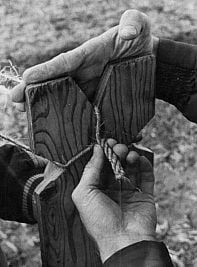
When the plies are twisted, pull them from the back of the winding board, twisting them into rope. Move the board forward. John wears gloves to protect his hands from the sisal.
The rope is almost finished. Remove the wrapping board when you get to the end of the rope, winding up to the hooks.
When making a sisal rope, be very careful that the small fibers on the strands don't get tangled between the three plies as they are wound. Separate these by using your fingers. The three plies are now tightly twisted. The next step is to twist those plies into a rope.
Twisting the Plies into Rope
Be sure there is a lot of tension in the plies before twisting the rope. The person winding the handle of the rope machine should wind the rope whenever needed. One person standing behind the winding board will twist the rope while another holds the board the plies are wound on. As the person holding the board eases the tension, the back person grasps the three plies where they cross from the back of the winding board, pulling all three plies back from the board and twisting the rope in a clockwise direction. With released tension, the three ends will twist into one strand, making the end of the rope. The person holding the winding board allows it to move toward the rope machine slightly as the rope twists.
Put a hog clip, or some other type of Clip, in the end of the rope so the plies won't lose tension and untwist.
The rope almost twists itself because of the tension in the plies. The person holding the board tightly pushes towards the person twisting the rope. This keeps the rope from twisting too fast, making the rope tighter. The one holding the board walks slowly towards the rope machine as the other twists the rope off behind the board. The portion of the rope already twisted is no longer on the board, but trails behind the winding board. The third person turns the handle of the machine as the other two need him to. He needs to keep tension in the plies because the strands lose their tension as the rope twists. He needs to turn the handle until it is hard to turn or kinks start to appear in the strands. He then waits while the rope is twisted toward him. When the rope is twisted about a foot from the machine, take the plies off the winding board as it is no longer needed so close to the machine. Continue twisting the rope right up to the hooks.
Removing the Rope from the Machine
You need something to finish off this end of the rope that holds the three plies so they don't untwist. Dr. Schendel uses hog rings. Open a ring with pliers. Twist the ring slightly so the two ends do not meet exactly when the ring is squeezed back together.
Put an ice pick, or something long enough to hold all the loops from the three hooks, through the loops on the first hook. Slip them onto the pick and off the hook. Next slip the loops from the second hook onto the pick with the loops from the first hook. Do the loops from the third hook the same way.
Hold the ice pick with the loops in one hand and the rope ring in the other. Work each loop onto the ring. This may be difficult if the loops are tight. Close the ring with pliers, clamping the ring shut very tightly.
Stretching the Rope
After the rope is finished, put it around something sturdy such as a clothesline pole and pull hard on it, running it back and forth. This action stretches all the fibers into place and pulls any kinks from the rope.
Singeing the rope
If using a binder twine material, you may need to singe off the loose fibers sticking out all over to make a more attractive rope and one easier on your hands. Set some newspaper on fire and run the rope through it, just as singeing a chicken.
Difference between Two and Three Ply Rope
The difference between the two and three ply rope is the number of plies used. We have given instructions for making the three ply rope. For the two ply rope, use two plies of strands twisted together. Make two ply rope on the rope machine by using the first and third hooks only. Make it just like the three strand rope except for stretching it on the winding board.
To stretch the strands on the board make a slip knot on the end of one strand the same as for the three ply rope. Put the loop over hook 1 on the machine. Walk the strand to the winding board, bring it through notch 1 behind the board to notch 3, and walk the strand back to hook 3. After looping over hook 3, reverse this process, going back through notch 3 to notch 1 and back to hook 1. Continue until reaching the desired thickness and tie the strand off the same as for the three ply rope.
Different colors of rope material can be used in the strands to have different colors in the plies. Each new color strand needs to be put on the hook of the rope machine with a slip knot.
It is better not to have to splice the strands in the middle. When changing color or you come to an end, do it at a hook.
MAKING A HALTER
A halter is a very useful item that can be made from the homemade rope. It can be made from the two or three ply rope. These directions are for a halter from a two ply rope fourteen feet long, but the rope could be any length depending on the length of the lead rein.
1. Fold one end over 22 inches.
2. Go down from the fold 1 1/2 inches or a few twists on the long end. Separate the two plies and pass the short end through this division, leaving a loop about 1 1/2 inches. Do not let this loop pass through.
3. On the short end, go down two twists or about 3/4 inch from the loop and separate the two plies. Now pass the long end through this division. This makes a permanent loop that will not increase or decrease in size. Pull the long end completely through.
4. At the end of the short side, make two loops by dividing the two plies. Untwist the plies two or three twists. The end of the rope will be one loop. Make the second loop by twisting one ply. Put one loop in front of the other. It will parallel the first loop almost automatically becuase of the natural twist in the rope. Pull the long end of the rope through this. These loops allow the long end to be pulled back and forth, making the halter adjustable. This step makes the headpiece of the halter.
5. Put the long end through the permanent loop made in step 2 and 3. This completes the nose piece which is also adjustable.
Dr. Schendel made halters from rug yarn in two colors. This made attractive halters which he suggested using for show halters.
He makes ropes not only for show, but also to use in his veterinary practice. He made one rope out of pink and black nylon twine which he made into a halter. This unusual color caused an interesting story.
"I received a call to go to somebody's home because one of their cows was going to have a calf, so I went over there as quick as I could," he said. "When I got to their house, we went out in the back pasture. After we got the cow under control, I took the new halter I had made off, and I laid it down in the middle of the pasture. I forgot it when I left.
"Then about six months later or a year later, I went to his place, and he had a cow tied up with my pink and black halter. I said, 'Hey, where did you get that? That's mine!' He said, 'I'm wondering, too. I found that thing out in my back pasture. I thought somebody was trying to steal my cows!'
"He had trained his cows to lead because he showed them at the fair. He thought somebody was out there trying to put a halter on one to get it out the back way where he couldn't see what they were doing from the house. He was relieved to realize that was my halter."
Dr. Schendel finishes a halter.
Fox trotting horse, Stepper wears one.
